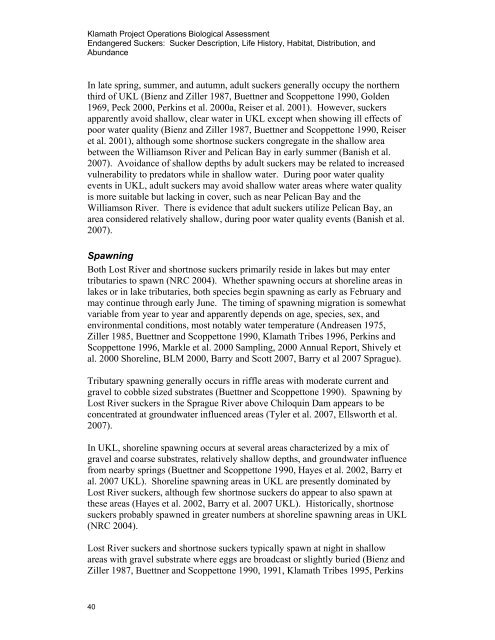Our new Biological Assessment is out - Klamath Basin Crisis
Our new Biological Assessment is out - Klamath Basin Crisis
Our new Biological Assessment is out - Klamath Basin Crisis
You also want an ePaper? Increase the reach of your titles
YUMPU automatically turns print PDFs into web optimized ePapers that Google loves.
<strong>Klamath</strong> Project Operations <strong>Biological</strong> <strong>Assessment</strong><br />
Endangered Suckers: Sucker Description, Life H<strong>is</strong>tory, Habitat, D<strong>is</strong>tribution, and<br />
Abundance<br />
In late spring, summer, and autumn, adult suckers generally occupy the northern<br />
third of UKL (Bienz and Ziller 1987, Buettner and Scoppettone 1990, Golden<br />
1969, Peck 2000, Perkins et al. 2000a, Re<strong>is</strong>er et al. 2001). However, suckers<br />
apparently avoid shallow, clear water in UKL except when showing ill effects of<br />
poor water quality (Bienz and Ziller 1987, Buettner and Scoppettone 1990, Re<strong>is</strong>er<br />
et al. 2001), although some shortnose suckers congregate in the shallow area<br />
between the Williamson River and Pelican Bay in early summer (Ban<strong>is</strong>h et al.<br />
2007). Avoidance of shallow depths by adult suckers may be related to increased<br />
vulnerability to predators while in shallow water. During poor water quality<br />
events in UKL, adult suckers may avoid shallow water areas where water quality<br />
<strong>is</strong> more suitable but lacking in cover, such as near Pelican Bay and the<br />
Williamson River. There <strong>is</strong> evidence that adult suckers utilize Pelican Bay, an<br />
area considered relatively shallow, during poor water quality events (Ban<strong>is</strong>h et al.<br />
2007).<br />
Spawning<br />
Both Lost River and shortnose suckers primarily reside in lakes but may enter<br />
tributaries to spawn (NRC 2004). Whether spawning occurs at shoreline areas in<br />
lakes or in lake tributaries, both species begin spawning as early as February and<br />
may continue through early June. The timing of spawning migration <strong>is</strong> somewhat<br />
variable from year to year and apparently depends on age, species, sex, and<br />
environmental conditions, most notably water temperature (Andreasen 1975,<br />
Ziller 1985, Buettner and Scoppettone 1990, <strong>Klamath</strong> Tribes 1996, Perkins and<br />
Scoppettone 1996, Markle et al. 2000 Sampling, 2000 Annual Report, Shively et<br />
al. 2000 Shoreline, BLM 2000, Barry and Scott 2007, Barry et al 2007 Sprague).<br />
Tributary spawning generally occurs in riffle areas with moderate current and<br />
gravel to cobble sized substrates (Buettner and Scoppettone 1990). Spawning by<br />
Lost River suckers in the Sprague River above Chiloquin Dam appears to be<br />
concentrated at groundwater influenced areas (Tyler et al. 2007, Ellsworth et al.<br />
2007).<br />
In UKL, shoreline spawning occurs at several areas characterized by a mix of<br />
gravel and coarse substrates, relatively shallow depths, and groundwater influence<br />
from nearby springs (Buettner and Scoppettone 1990, Hayes et al. 2002, Barry et<br />
al. 2007 UKL). Shoreline spawning areas in UKL are presently dominated by<br />
Lost River suckers, although few shortnose suckers do appear to also spawn at<br />
these areas (Hayes et al. 2002, Barry et al. 2007 UKL). H<strong>is</strong>torically, shortnose<br />
suckers probably spawned in greater numbers at shoreline spawning areas in UKL<br />
(NRC 2004).<br />
Lost River suckers and shortnose suckers typically spawn at night in shallow<br />
areas with gravel substrate where eggs are broadcast or slightly buried (Bienz and<br />
Ziller 1987, Buettner and Scoppettone 1990, 1991, <strong>Klamath</strong> Tribes 1995, Perkins<br />
40










